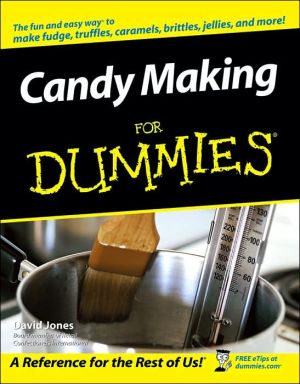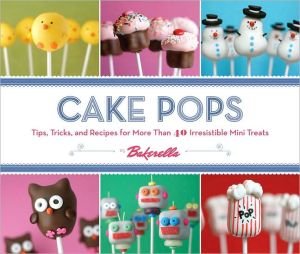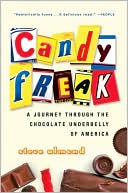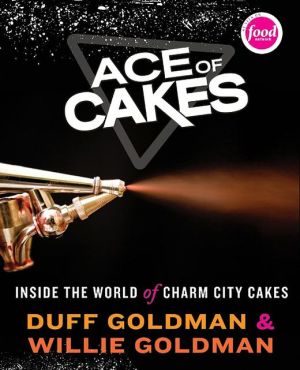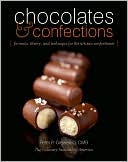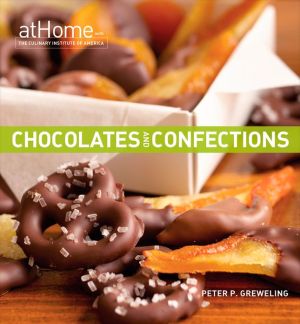Candy Making For Dummies
How sweet it is! More than 100 recipes plus terrific tips and tricks\ Explore the art of cooking candy and create sweet masterpieces!\ If you want to concoct irresistible treats for your friends and family, this book gets you cooking! You'll discover proper techniques and use them to create incredible candies. Recipes range from fondues to fondants, simple meltaways to decadent truffles, fun kids' treats to cream-filled delicacies. Indulge!\ Discover how to\ * Choose the proper utensils and...
Search in google:
How sweet it is! More than 100 recipes plus terrific tips and tricks Explore the art of cooking candy and create sweet masterpieces! If you want to concoct irresistible treats for your friends and family, this book gets you cooking! You'll discover proper techniques and use them to create incredible candies. Recipes range from fondues to fondants, simple meltaways to decadent truffles, fun kids' treats to cream-filled delicacies. Indulge! Discover how to * Choose the proper utensils and ingredients * Melt, temper, and mold chocolate * Fine-tune your skills with professional secrets * Create special holiday treats * Bag, box, or wrap candies for gifts
Candy Making For Dummies\ \ By David Jones \ John Wiley & Sons\ ISBN: 0-7645-9734-5 \ \ \ Chapter One\ Candy Making Made Easy (Because It Is)\ In This Chapter\ * Gearing up to make candy\ * Identifying some great confections\ * Checking out special uses for your candy-making skills\ One point I stress throughout this book is that candy making is pretty easy. After you learn a few basics and prepare yourself and your environment according to my simple guidelines, all you have to do is follow a few procedures. I hate to say this, but if I can make candy, you can make candy.\ When I train new staff members in my candy shop, I observe that, at first, they're hesitant and overly careful about handling the product, as if it were very fragile. I assure them that they will not hurt the candy by being aggressive. I don't want them to be afraid of the candy, and you shouldn't be afraid, either. Most products you make are quite tolerant, and you can stir them hard, slap them, or just generally be rough with them. Don't be afraid to get your hands a little messy, and don't worry about making a bit of a mess. Have fun, because you're in charge.\ To make a point, when someone observes that I have a spot of chocolate on my face, I dab even more on and ask, "Where, here?" Then I touch another spot with a big dab and ask, "Or was it here?" Before I finish, I have chocolate all over my face, but the new person is relaxed, confident that I am crazy and not worried about making amess. I want you to have that feeling without my having to come to your house to make a fool of myself. And before I continue with the "newbie," I wash up. I do have a few rules.\ In this chapter, I introduce you to my world: the world of candy making. I introduce you to the basics of preparation, tell you about a variety of sweet treats, and share tips for special candy situations. Through this book, I hope you'll acquire some of the affection for confection that I have. Candy has been very good to me, to paraphrase the old Saturday Night Live line, and I have made a career of pleasing folks with simple confections. Now you have the opportunity to bring a little joy to your family and loved ones as well as to yourself.\ Getting Set to Make Candy\ Your journey to becoming a candy-making expert begins with the simplest preparations. You must properly prepare yourself in terms of kitchen space, utensils, and ingredients. The better you prepare yourself for cooking, the easier your experience will be and the quicker you will become adept at making candy.\ REMEMBER\ Now, I certainly don't expect you to reproduce a candy kitchen in your home. But I do believe that the closer you come to creating a cool, dry environment and the better equipped you are with basic candy tools, the better your results will be. Factor in using only quality ingredients, and you're in pretty good shape.\ In this section, I discuss how to prepare your kitchen and tell you about the tools and ingredients you need for your candy.\ Ensuring that you and your kitchen are ready REMEMBER\ As you read through this book, you'll find numerous opportunities to make some great candies, and the hardest decision may be where to start. What should you do first? A good idea is to read several recipes that catch your eye and find something pretty simple. I've tried to make all the recipes in this book easy, but some are easier than others. Try one or two simple recipes and then select a recipe for a candy that you or someone in your family would really enjoy. Make that recipe. At that point you've gained confidence, and you're on your way.\ I know you can't turn your home kitchen into a candy kitchen any more than you can turn it into a restaurant when you prepare dinner. Your objective, then, should be to create the best atmosphere possible to assure that your candies turn out great. You want a cool, dry environment to make a lot of candies, with an ideal room temperature of 70 to 72 degrees. Organize your ingredients; make sure that you have plenty of counter space; and check to see that your equipment is in working order, too.\ See Chapter 2 for more ideas about how to prepare yourself and your kitchen before you begin making candies.\ Finding the proper tools\ Aside from having the necessary ingredients, few things expedite production like having the right tools for the task at hand. For a full list of the equipment you need, check out Chapter 3. Most utensils you use in candy making are available in a grocery or discount store; kitchen stores and commercial equipment suppliers are two other options. You can also find many specialty items online (see Chapter 24 for a list of online suppliers).\ TIP\ Some of the handiest tools you can use include\ \ Measuring tools, such as measuring cups, measuring spoons, candy thermometers, and chocolate thermometers\ \ \ Pots and pans, including a double boiler, saucepans, baking pans, and cookie sheets\ \ \ Kitchen essentials, such as large knives, microwaveable bowls, spoons, whisks, and spatulas\ \ \ Small appliances, such as food processors and mixers\ \ \ Specialty tools, such as a marble slab, a piping bag, dipping tools, and chocolate molds\ \ \ Tools for cooling and storage, such as cooling racks and plastic containers\ \ Using great ingredients\ Most candy recipes use ingredients that you can find at your local grocery store. Among the most important types of ingredients are\ \ Sugars and sweeteners: These ingredients form the basis for virtually all candy recipes. You can use solid sweeteners, such as granulated sugar, confectioners' sugar, and brown sugar; you can also put liquid sweeteners, such as corn syrup and honey, to good use.\ \ \ Dairy products: "Cream" has many meanings in the world of candy making. The cream used to make fine candies may range from 10 percent butterfat (with the use of half-and-half) to more than 40 percent butterfat (with the use of heavy cream), and how a recipe turns out depends on what type of cream you use. Other useful dairy ingredients include butter, whole milk, condensed milk, and sweetened evaporated milk.\ \ \ Nuts: People can be very particular about the nuts they like in their candy. Some of the most popular nuts are peanuts, pecans, walnuts, and cashews. Nuts provide a wonderful crunch in candies, and they impart their own special, delicious flavors.\ \ \ Chocolate: You should appreciate the fine differences among the types of chocolates, in terms of the range from white to extra dark and in regard to quality. You can cut corners in quality, but I never recommend doing so; don't save a few pennies on a major ingredient if you want good results. The chocolate substitutions I offer as variations of recipes don't lower the quality of your candy; I offer those substitutions quite often so you can make varieties of a recipe with similar results.\ \ TIP\ When you gather the ingredients for a recipe, know that I had a reason for making those choices and that variations may produce different results than what the recipe intended.\ Chapter 4 has everything you need to know about choosing and using the preceding ingredients. I also provide you with a list of less common (but still important) candy ingredients.\ Checking Out Delicious Types of Candies\ I understand that you're capable of enjoying just so much of my text. Ultimately, you need to be exposed to some recipes, and you're not to be disappointed. You find about 100 recipes, and I group them by types of candies: creamy and chewy, nutty, and chocolaty.\ REMEMBER\ Before you try any recipe, read through the available recipes and find one you're certain that you understand. Make that recipe first to get the feel of what you're doing, and move on from there. You should be able to prepare any candy in the book simply by following the directions I offer. If you feel like you need to ease into the more difficult recipes, you have that opportunity.\ Fixing creamy and chewy treats\ You encounter many excellent recipes in Part II, which features creamy and chewy concoctions.\ In Chapter 5, I tell you how to prepare fondue. Fondue is a versatile treat that makes a nice interactive dessert; each family member gets to create his or her own special treat. Fondues are also great for romantic settings.\ Chapter 6 includes directions for making fondant - a combination of sugar corn syrup, and water - that you can use to prepare other candies, such as mints. One nice thing about this fondant recipe is that you don't have to do any cooking to make it.\ Another candy you make in Chapter 6 is the meltaway, which you can make in several flavors. The meltaway, a smooth piece that usually includes chocolate and some added fat (don't let that word scare you), is easy to make, and you should derive some pleasure from making something so good with so little effort.\ Caramel is a major piece of the candy puzzle and, in Chapter 7, you find tasty caramel recipes that you can use in making other candies. You can make so many great candies using caramel, like caramel apples, caramel pecan clusters, and more.\ One of the confections that my company could never be without is divinity, which I cover in Chapter 8. Although divinity is similar in appearance to marshmallow, this confection uses egg whites for aeration, which provides a very light, airy piece.\ In Chapter 9, you find recipes for fudge. Fudge is one of those things that seems to bring a smile to folks' faces, so be prepared to create a few smiles as you make your own fudge. With the recipes in Chapter 9, you can make simple microwave fudge and progress to cooked fudges, which require a little more time. Cooked fudges involve actual cooking in a saucepan, which takes you a bit closer to being a real candy maker. You should enjoy the variety of flavors of fudge as well.\ Chapter 10 provides you with easy recipes for good, light homemade marshmallows and fruit jellies. Marshmallows and jellies are cousins in the candy world because you make both with gelatin. You can master these candies using one flavor and, with only a couple of changes, you can make a variety of flavors. You even have the chance to make a very easy marzipan (for those of you who like that almond-based candy).\ Noshing on nut-based candies\ Sometimes you just have to get a little nutty, and you can fulfill that urge with a nice variety of the nutty confections in Part III.\ One truly great candy that you commonly find in a candy shop is toffee, a buttery-rich, crunchy confection that's cooked to about 300 degrees. I show you how to make toffee as well as its cousin, the crunch, in Chapter 11. Crunches contain slightly less butter than toffees, but you still get a great buttery taste.\ I also cover the praline in Chapter 11. This candy, which has Southern roots, is a delightful confection traditionally made with sugar, corn syrup, butter, and pecans. You should enjoy making this one; I know I do!\ The first candy that my wife and I ever made was peanut brittle. In Chapter 12, you have your own chance to make some peanut brittle as well as a few other brittle variations. Brittles are cooked to a high temperature (around 300 degrees), so you're doing some serious cooking. But I think you'll enjoy the results.\ If you consider popcorn to be a salty movie treat, I have a few surprises in store for you. In Chapter 13, I show you how to take basic popcorn and make a caramely, nutty treat. You also can add white chocolate to make a delightfully sweet, melt-in-your-mouth confection that almost seems cool when you eat it. You won't think of popcorn as just a snack for movies anymore.\ From pralines to toffee to pecan rolls, you should be able to find a nutty confection to match your taste as well as your family's. Think of the smiles on your family members' faces when they taste the delicious pecan rolls you make for them. Imagine how they'll praise you for your peanut or pecan brittle. You will be so loved!\ Meanwhile, I offer you an extremely simple nut-based recipe to get you started on your candy-making journey.\ Dream Dates\ This not-too-sweet treat - which includes roasted almonds, dates, confectioners' sugar, cocoa, and cinnamon - is good for so many occasions. You can offer it when a few friends come over and you don't want to tempt them with something too heavy or too sweet (not to mention that you can make this in just a few minutes).\ Preparation time: 10 minutes\ Yield: 45 pieces\ 1 3/4 cups pitted dates (about 45)\ 2/3 cup whole roasted, salted or unsalted almonds (about 90)\ 1/2 cup confectioners' sugar\ 1 teaspoon unsweetened cocoa\ 1/2 teaspoon cinnamon\ 1 Stuff each date with two of the almonds.\ 2 In a freezer bag, combine confectioners' sugar, cocoa, and cinnamon, and seal the bag. Shake the bag well to blend the ingredients and pour the contents onto a small plate.\ 3 Roll each date in the mixture to coat. You can store the dates overnight in a plastic container at room temperature.\ Per serving: Calories 36 (From Fat 10); Fat 1g (Saturated 0g); Cholesterol 0mg; Sodium 0mg; Carbohydrate 7g (Dietary Fiber 1g); Protein 1g.\ Entering the wide world of chocolate\ My personal area of candy making, and that of many others, is the world of chocolate. Of all the candy that is made in my kitchens, nothing gives me the satisfaction that chocolate brings. In Part IV, I introduce you to the joy of chocolate and offer you the opportunity to put this information to work.\ To coat and decorate many chocolate confections, you must temper the chocolate. Tempering is a controlled process of heating and cooling chocolate using movement to achieve the proper temperature and crystal structure so that your candy has a nice, glossy finish. It isn't rocket science, and you find that out in Chapter 14; you just need to know how to properly chop and melt chocolate in a double boiler or microwave. You can use one of several methods to temper: hand tempering, chunk tempering, or machine tempering. After you achieve the basic skills necessary, you're on your way to a lifetime of pleasure. I make the tempering process as easy as possible for you, but the only way to become proficient in handling chocolate is by getting your hands into the chocolate pot.\ Chapter 15 is all about dipping treats into chocolate. You can dip treats by hand or using special dipping tools, and the variety of items you can dip is endless. The list includes fruits, pretzels, and much more.\ Chapter 16 gives you the lowdown on barks and clusters. These two candies have the same ingredients (usually chocolate and nuts), but you shape them in different ways:\ \ Bark is poured into sheets and cut into bar-size pieces.\ \ \ Clusters are shaped into bite-size pieces about 112 inches wide.\ \ Chapter 17 covers creams, which are sugar-based centers. You find out how to make different cream centers and what to do with them when they're set: You dip them in your favorite chocolate, of course!\ Chapter 18 is all about delectable truffles, which I put at the top of the list of the finest chocolate products available. The truffle, which is basically a rich center of chocolate and cream encased in a thin shell of chocolate, is simply one fine bite. Actually, most truffles are just that: one bite. I show you how to make, roll, and coat truffle centers. I also guide you on piping thin (but still rich) centers into chocolate shells.\ Chapter 19 presents several fun methods on molding chocolates: solid molding, hollow molding, and shell molding. You can mold chocolates for so many different occasions, and you're pretty much limited only by your imagination; you can find a mold for just about anything you can think of.\ (Continues...)\ \ \ \ \ Excerpted from Candy Making For Dummies by David Jones Excerpted by permission.\ All rights reserved. No part of this excerpt may be reproduced or reprinted without permission in writing from the publisher.\ Excerpts are provided by Dial-A-Book Inc. solely for the personal use of visitors to this web site. \ \
Introduction. Part I: Welcome to Candyland. Chapter 1: Candy Making Made Easy (Because It Is). Chapter 2: Preparing Yourself (and Your Kitchen) for Candy Making. Chapter 3: Selecting the Right Tools. Chapter 4: Picking Quality Ingredients. Part II: Concocting Creamy and Chewy Delights. Chapter 5: Creating a Stir with Fondue. Chapter 6: Focusing on Fondant, Mints, and Meltaways. Chapter 7: Caramel Contentment. Chapter 8: Doctoring Divinity. Chapter 9: Whipping Up Quick and Easy Fudges. Chapter 10: Making Magic with Marshmallows, Fruit Jellies, and Marzipan. Part III: Getting a Little Nutty. Chapter 11: Taking On Crunches, Toffees, and Pralines. Chapter 12: Breaking Out the Brittles. Chapter 13: Discovering Amazing Uses for Popcorn. Part IV: Becoming a Chocolate Artist. Chapter 14: Chopping, Melting, Tempering, and Storing Chocolate. Chapter 15: Dipping Delicious Treats into Chocolate. Chapter 16: Taking a Bite Out of Barks and Clusters. Chapter 17: Rolling Along with Wonderful Creamy Centers. Chapter 18: Impressing with Incredible Truffles. Chapter 19: Know How to Mold ’Em. Part V: Having Special Fun with Candy. Chapter 20: Creating Holiday Magic. Chapter 21: Bring In the Kids.9 Chapter 22: Making a Stunning Presentation. Part VI: The Part of Tens. Chapter 23: Ten Wonderful Web Sites for Candy Recipes. Chapter 24: Ten (or So) Great Places to Buy Candy-making Supplies. Chapter 25: Ten (or So)Cool Candy Companies to Visit. Chapter 26: Ten Troubleshooting Tips for Candy Makers. Appendix: Metric Conversion Guide. Index.
